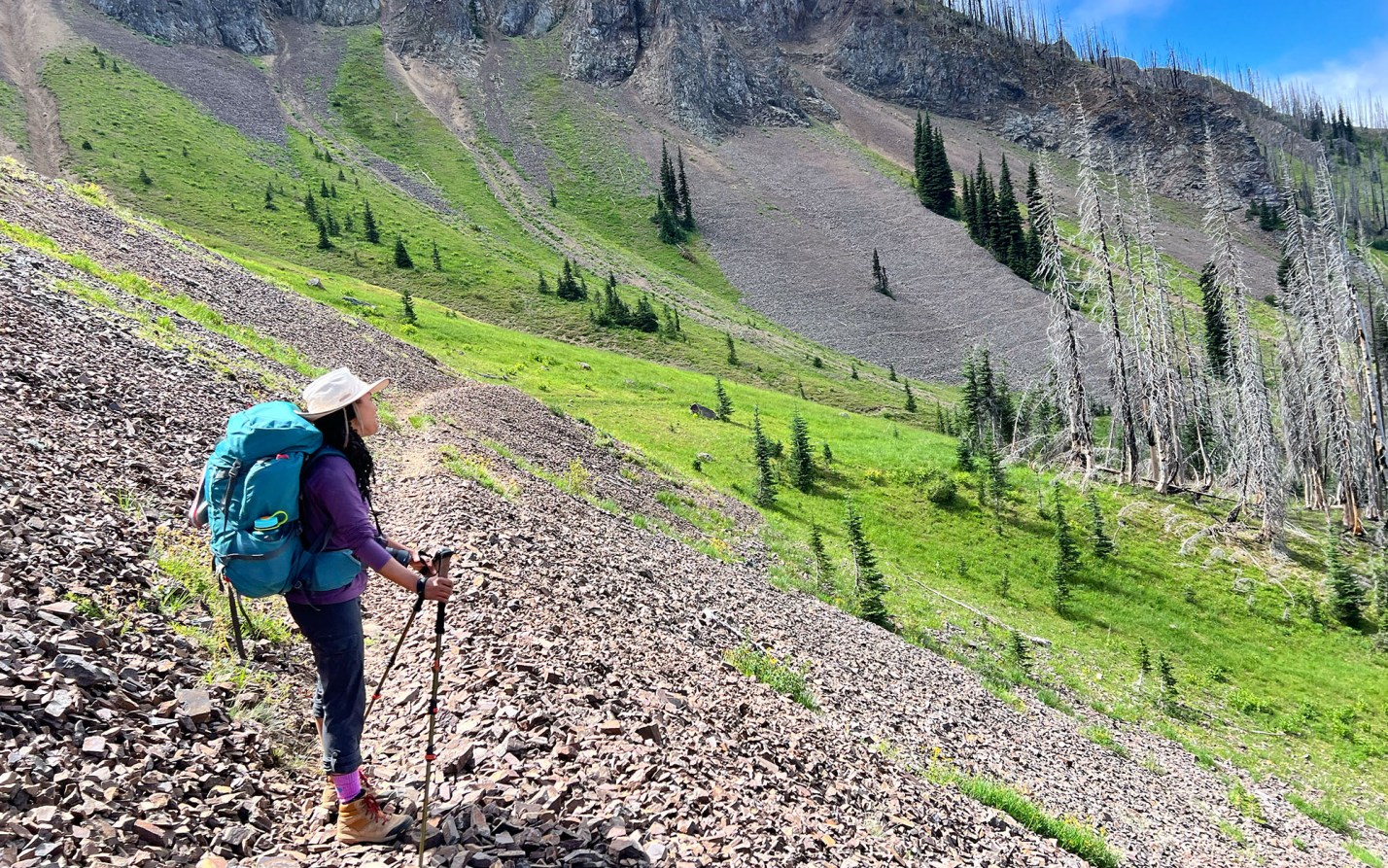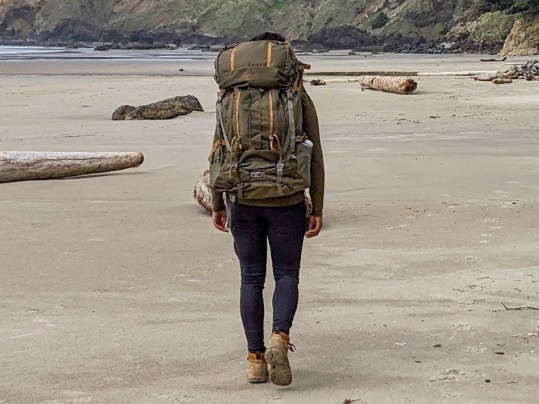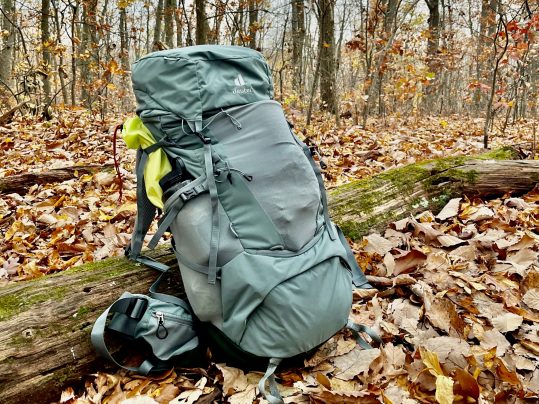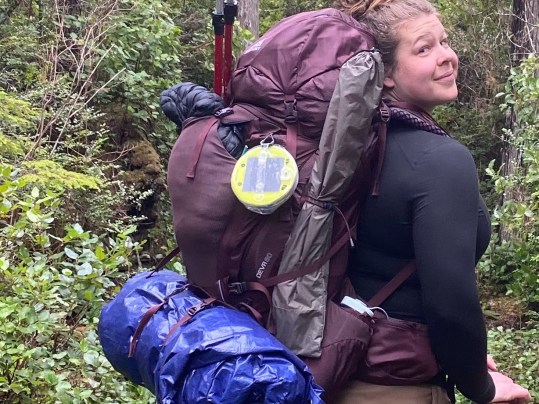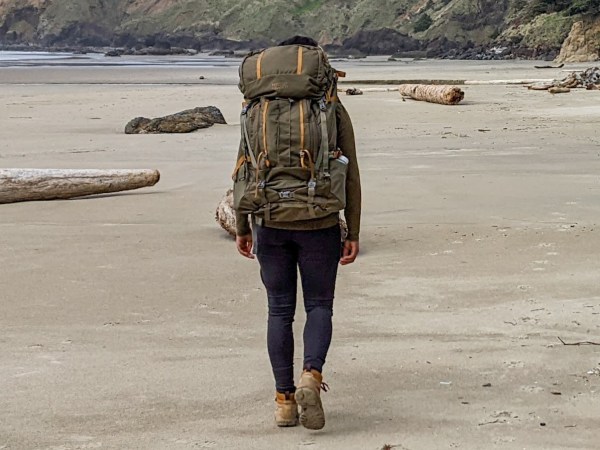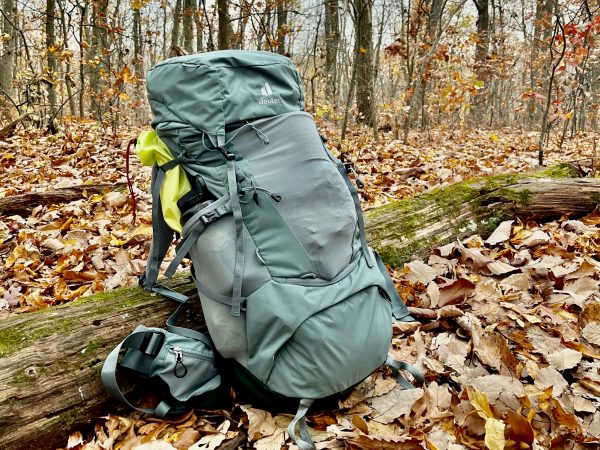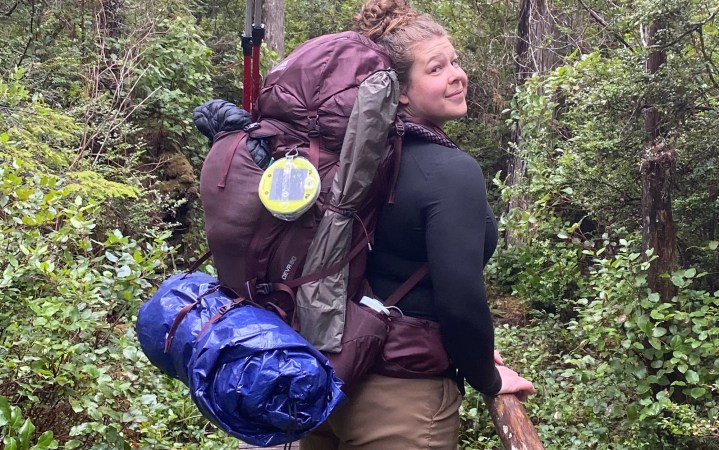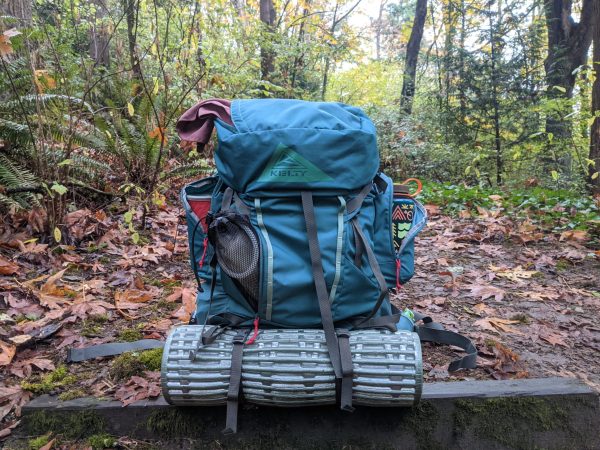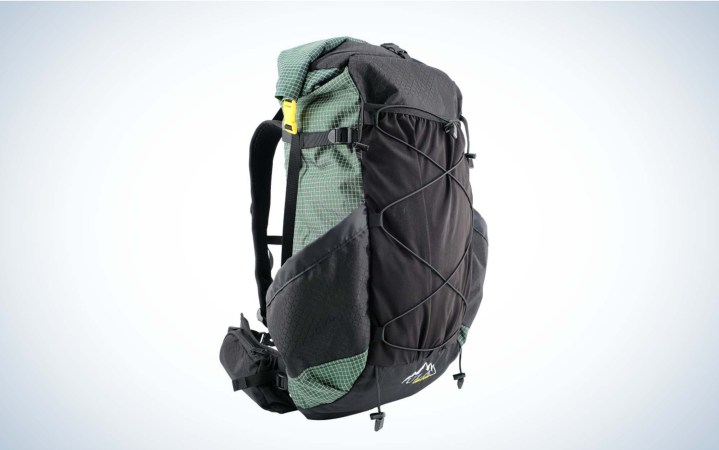We may earn revenue from the products available on this page and participate in affiliate programs. Learn More ›
Choosing the right backpacking backpack is tough. Even if you have the luxury of a nearby REI or Cabela’s, there is only so much you can learn about how comfortable a backpack is from walking around the store. To really get a feel for the fit of a pack, you have to take it out into the field for a few days. Does it bruise your hips on day two? Pull at your clavicle when it’s fully loaded? Can you balance the load of your current backpacking kit properly? To help you choose the best backpacking backpack for your body type and shape, I sent three experienced backpackers with different physical builds into the field with popular packs from Deuter, Gregory, Big Agnes, Mystery Ranch, and Kelty.
- Best Overall: Mystery Ranch Bridger
- Best for Men: Deuter Aircontact Core
- Best for Women: Gregory Deva
- Best for Small Frames: Kelty Coyote
- Best Ultralight: ULA Circuit
Topics Covered (Click the text to jump to the section)
How We Tested the Best Backpacking Backpacks
Meet Our Testers
Mystery Ranch Bridger Review
Deuter Aircontact Core Reviews
Gregory Deva Review
Kelty Coyote Review
ULA Circuit Review
The Rest of the Field
Things to Consider When Choosing a Backpacking Backpack
How We Tested the Best Backpacking Backpacks
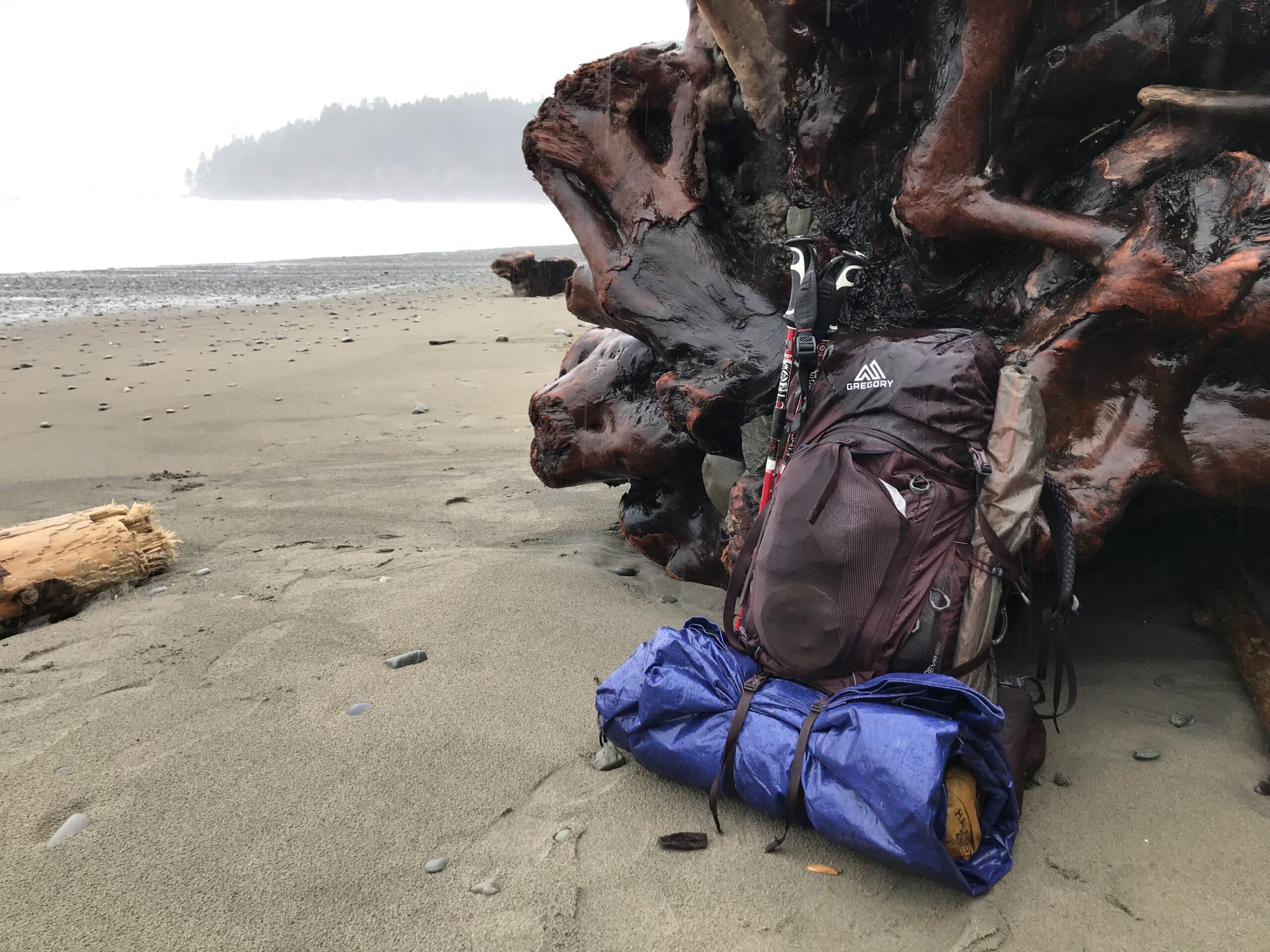
With plenty of backpacking gear, it’s possible to objectively quantify what the “best” products are in any category. For example, the best backpacking water filters need to be able to perform reliably across a wide variety of water sources. The best tent stakes need to have great holding power at a low weight. The best backpacking quilts maximize warmth for weight and comfort. But what makes for the best backpacking backpack is more subjective.
The Challenge of Finding the Best Backpacking Backpack
That’s because backpackers are not a one-size-fits-all group. Our loads are different: 20 pounds for an overnight is going to carry a lot differently than 40 pounds for a weeklong trip. Then there is how you pack that gear into your pack—do you use a water bladder or Nalgenes? Are you carrying lots of layers that you’ll need easy access to, or are you hiking in a fair-weather climate? But the biggest X factor of all is you: the shape of the hip belt, the curve of the shoulder strap, the fit of the torso all vary between backpacks, and choosing a backpack that’s wrong for your frame can result in everything from back pain to bruising along the hips or clavicle.
Testing the Packs in the Field
To help unpack which backpacking backpacks work with which body types, we selected an experienced panel of testers that span a range of hip and torso measurements. They then tested a series of backpacks, from the likes of Gregory, Mystery Ranch, Deuter, Big Agnes, and Kelty, in parallel. Each backpack went out for a minimum of an overnight with each tester, and often for much longer than that. Backpacks were tested for a minimum of 50 miles between all three testers, with their top picks often exceeding 100 miles. Testing occurred throughout the year on both coasts, in conditions ranging from scorching summer temperatures to light snow.
Scoring the Packs
At the end of their test, they each filled out a comprehensive testing sheet where they described their experience of the backpack from start to finish. They described how they packed each backpack, noting whether their gear fit or had to be rearranged. The adjustment points were checked for functionality, to ensure they could fit it appropriately to their frames. They then reported back on where and when pain occurred while they were out in the field, including strained shoulder muscles and bruised hips. While out in the field, the testers considered whether the design of the pack helped or hindered their ability to access their gear. They also scored each backpack from 1 (poor) to 10 (excellent) on the following:
- Fit: Could you adjust it to your satisfaction?
- Comfort: Did the pack cause you any pain or discomfort?
- Load Bearing: How did it handle a heavy load?
- Storage: Did the pack adequately hold all your gear?
- Accessibility: How easy was it to access all your gear in the field?
- Value: Is it worth the money?
I then compared their testing sheets against one another to determine where a comfortable fit was a commonality across all three testers, or where a difference in physical stature determined whether their experience was positive or negative. I also looked at how their different approaches to packing a backpacking kit affected whether a pack’s organizational system was a hindrance or help.
What About Plus Size Packs?
It’s worth noting that, in recent years, several brands, including Gregory and Osprey, have expanded their backpacking backpack collections to include plus size fits. While we did not include these backpacking backpacks in this series, they are an excellent place to start for anyone whose measurements are not included in the existing size ranges of other backpacking backpacks.
The Best Ultralight Backpacks
I also included our top pick from Outdoor Life’s test of the best ultralight backpacks, which was conducted along a section of the Oregon Coast Trail in April. There were five testers, including Diana Helmuth, with a range of experience from sub 500-hundred miles worth of backpacking to over 10,000 miles.
Meet Our Testers
Rebecca Ross
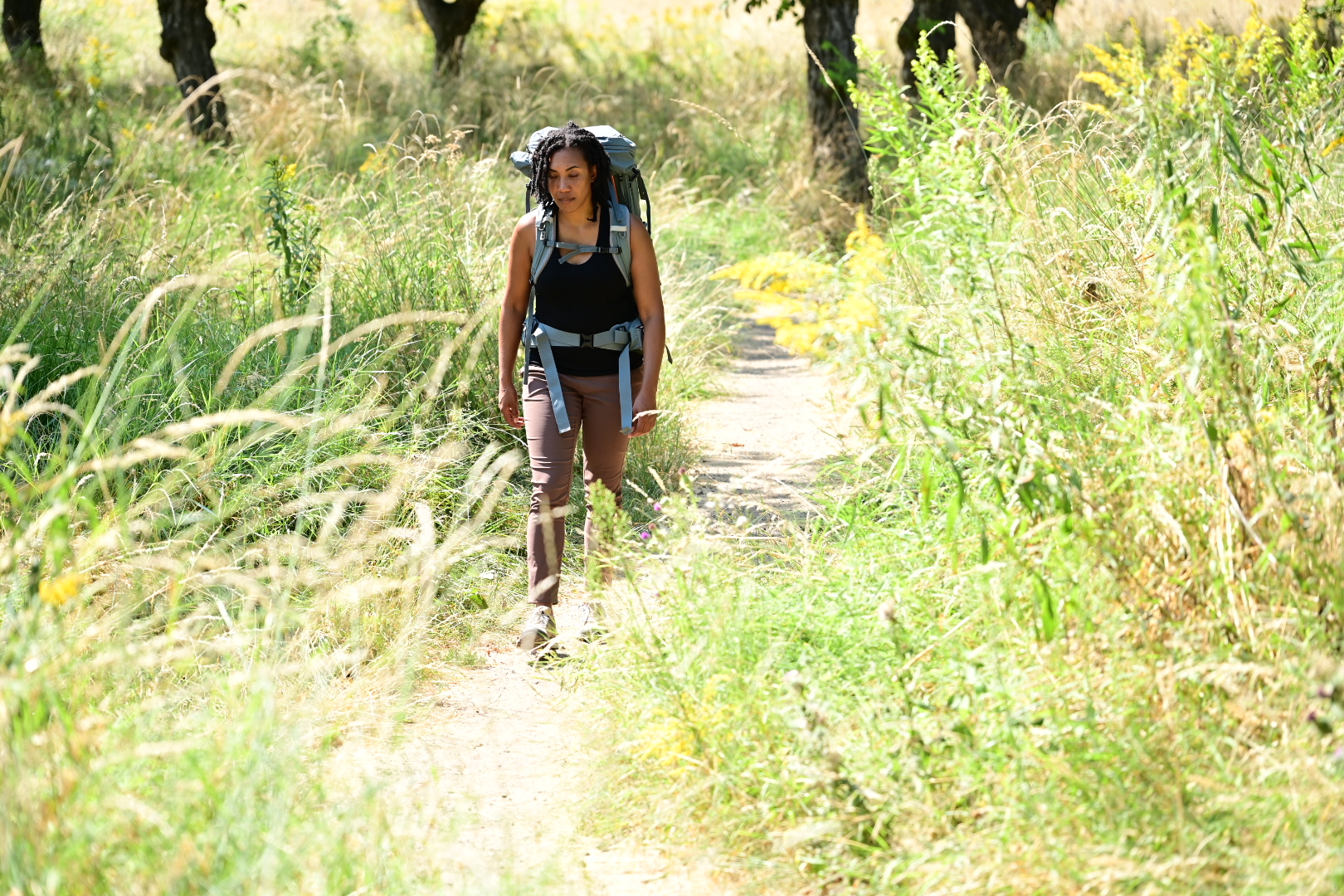
About
Rebecca grew up homeschooled in a small town of 180 people in Central California. At age 15, she moved to Portland and has been in the Pacific Northwest for over 20 years.
She has worked as a Race to Alaska photojournalist, stayed with a Berber family in Morocco’s Atlas Mountains, taught reproductive health and family planning to rural communities in Uganda’s Rwenzori Mountains, and has summited mountains in both the Republic of Georgia and her tallest peak, Pico de Orizaba, in Mexico, at 18,500 feet.
Stats
- Torso length: 16 inches
- Hip width: 32 inches
- Typically carries between 28 and 33 pounds
In her own words: “I’m 5 feet, 2 inches, with a short torso. I wear a size 2 or 4, but routinely check the children’s department when shopping for outerwear.”
Ross’s Report Card
| Category | Mystery Ranch Bridger 65 | Deuter Aircontact Core | Kelty Coyote | Big Agnes Parkview/Garnett | Gregory Baltoro/Deva |
| Fit | 9 | 3 | 10 | 4 | 10 |
| Comfort | 8 | 1 | 10 | 5 | 8 |
| Load Bearing | 10 | 9 | 10 | 7 | 8 |
| Storage | 10 | 9 | 10 | 9 | 10 |
| Accessibility | 7 | 7 | 9 | 9 | 10 |
| Value | 6 | 3 | 10 | 9 | 7 |
| Overall | 9 | 1 | 10 | 8 | 10 |
Diana Helmuth
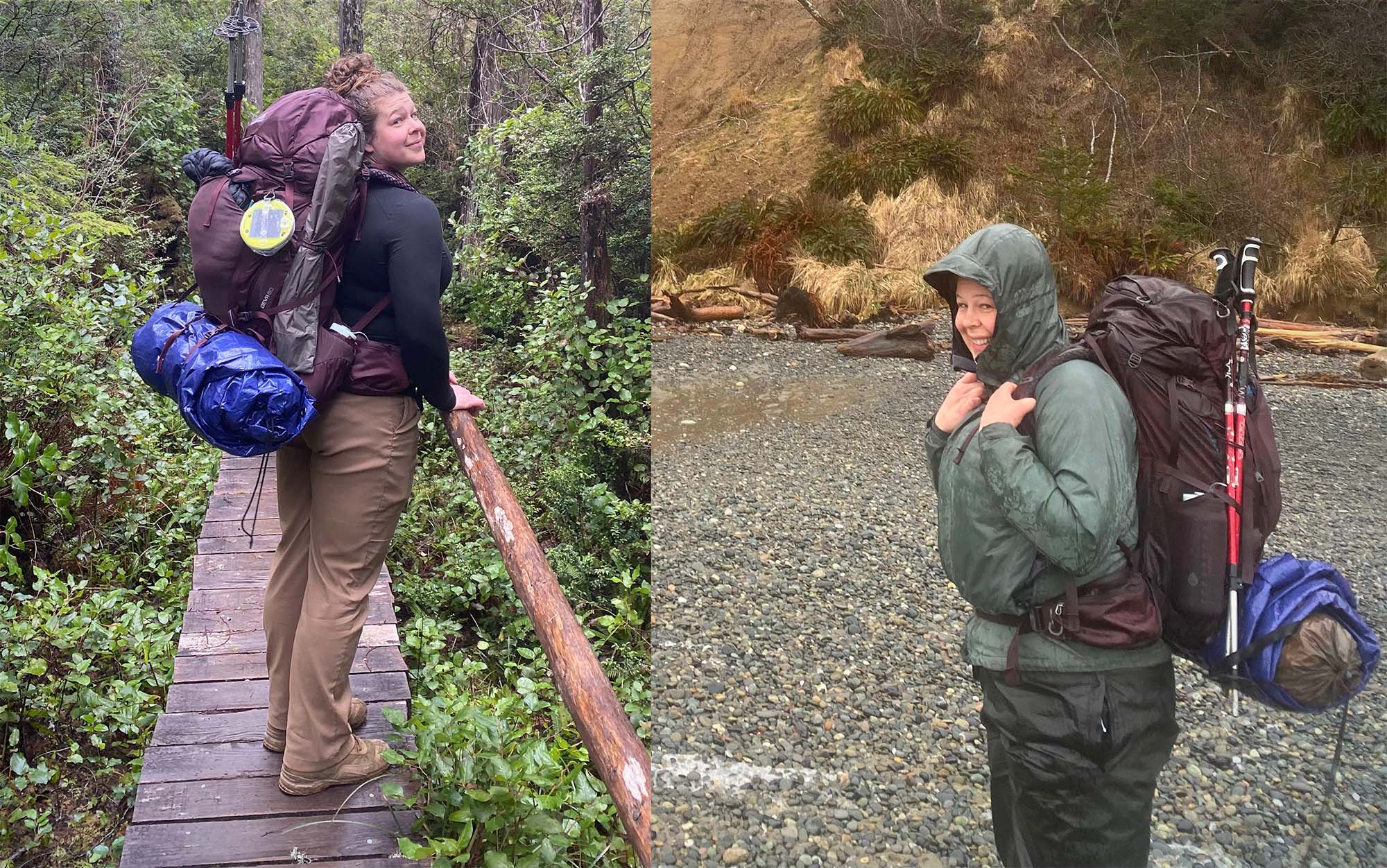
About
Diana started backpacking with her mother at an early age, and spent part of a year of secondary school focused on backpacking and wilderness education. Since then, she has hiked extensively throughout the western United States, Europe, and Chile. Her first book, How to Suffer Outside: A Beginner’s Guide to Hiking and Backpacking, won the National Outdoor Book Award for Best Instructional.
Stats
- Torso length: 18.5 inches
- Hip width: 43 inches
- Typically carries between 30 and 35 pounds
In her own words: “I’m a larger-than-average woman—5 feet, 10 inches and a dress size 14. I tend to go straight for men’s gear, as a rule.”
Helmuth’s Report Card
| Category | Mystery Ranch Bridger 65 | Deuter Aircontact Core | Kelty Coyote | Big Agnes Parkview/Garnett | Gregory Baltoro/Deva |
| Fit | 10 | 8 | 4 | 5 | 6 |
| Comfort | 10 | 8 | 2 | 5 | 5 |
| Load Bearing | 10 | 9 | 8 | 10 | 9 |
| Storage | 8 | 10 | 8 | 6 | 10 |
| Accessibility | 8 | 7 | 2 | 7 | 10 |
| Value | 5 | 8 | 7 | 5 | 7 |
| Overall | 8.5 | 8.3 | 5 | 6.3 | 7.8 |
Jason Boyle
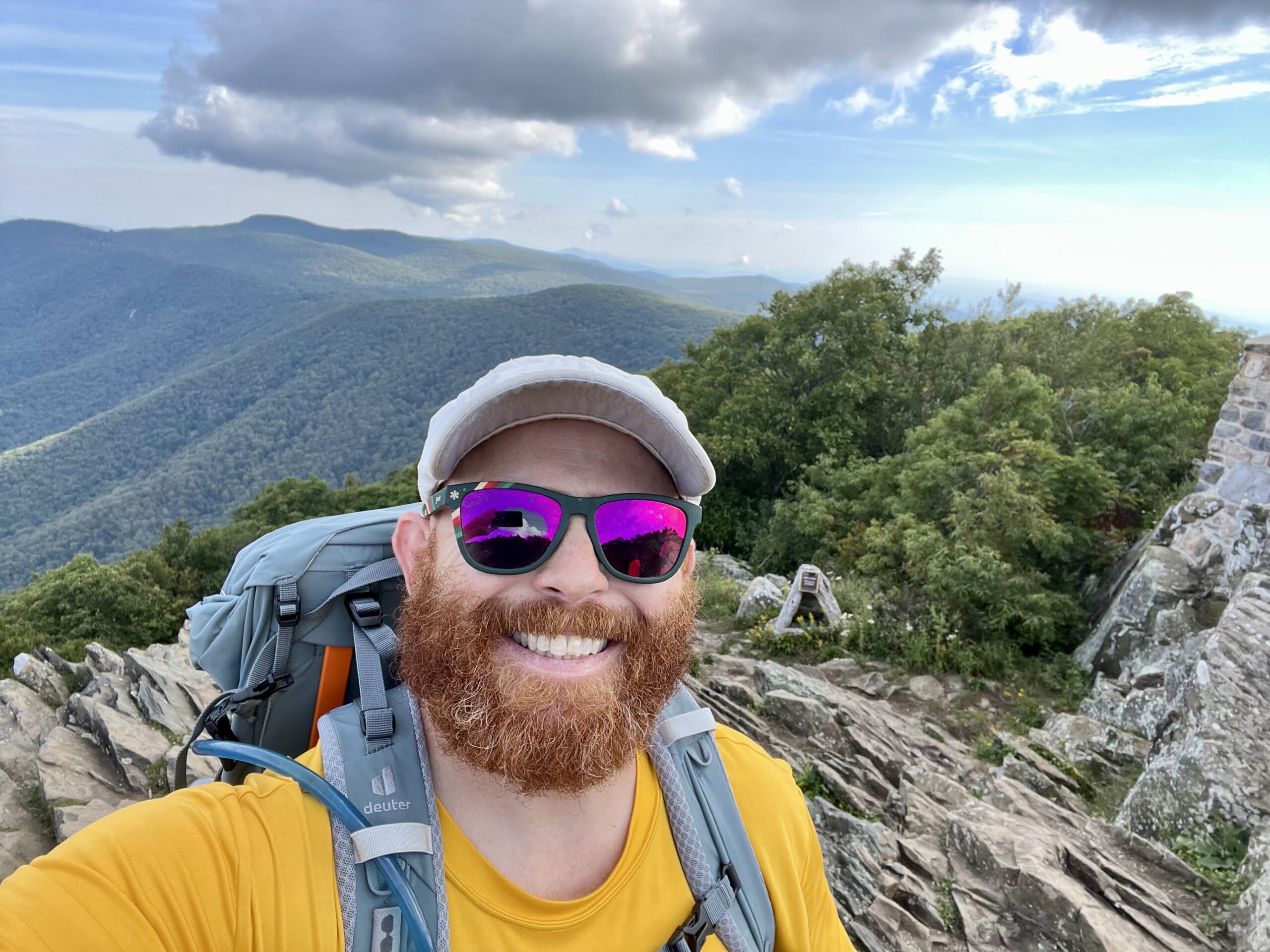
About
Jason’s love for the outdoors started over 30 years ago when he learned to backpack on the Pinhoti trail in Alabama as part of Scouts BSA. Since then, he has backpacked and camped all over the United States, including section hiking the Appalachian Trail, summiting Mt. Rainier (Tahoma) and Mt. Baker in Washington State, and hunting and fishing in Southeast Alaska. He currently calls Virginia home, and is in the process of hiking every trail in Shenandoah National Park.
Stats
- Torso length: 17.5 inches
- Hip width: 36 inches
- Typically carries between 35 and 40 pounds
In his own words: “I am 5 feet, 6 inches with a dad bod and massive calves.”
Boyle’s Report Card
| Category | Mystery Ranch Bridger 65 | Deuter Aircontact Core | Kelty Coyote | Big Agnes Parkview/Garnett | Gregory Baltoro/Deva |
| Fit | 8 | 10 | 6 | 8 | 8 |
| Comfort | 8 | 9 | 5 | 8 | 6 |
| Load Bearing | 8 | 9 | 5 | 8 | 7 |
| Storage | 7 | 8 | 6 | 8 | 5 |
| Accessibility | 7 | 8 | 6 | 6 | 6 |
| Value | 7 | 8 | 9 | 8 | 4 |
| Overall | 8 | 9 | 6 | 7.9 | 5 |
Best Backpacking Backpacks: Reviews & Recommendations
Best Overall: Mystery Ranch Bridger
Key Features
- Capacity: 63 liters
- Weight: 5.5 pounds
- Unisex Torso Fit: 15 to 24 inches
- Women’s Torso Fit: 14 to 22 inches
- Pockets: Removable top lid pocket with inner mesh pocket, two side stretch pockets, front pocket (not mesh) with two inner mesh pockets, two hip belt zip pockets, two shoulder strap pockets
- Adjustment Points: Attached hip belt, shoulder straps, load lifters, adjustable back panel, two sternum straps
- Comfortable up to 50 pounds (as reported by the testers)
- Warranty: Limited lifetime warranty
Pros
- Comfortable across a wide range of body types
- Pockets and entry points helped keep testers organized
Cons
- Heavy
- Expensive ($375 for the 65 liter)
Before the testers took the Mystery Ranch Bridger out into the field, I was starting to get pessimistic. We had already tested four other packs, and no backpack had comfortably fit all three testers’ different body types. Was there even such a thing as a “best overall backpacking backpack”?
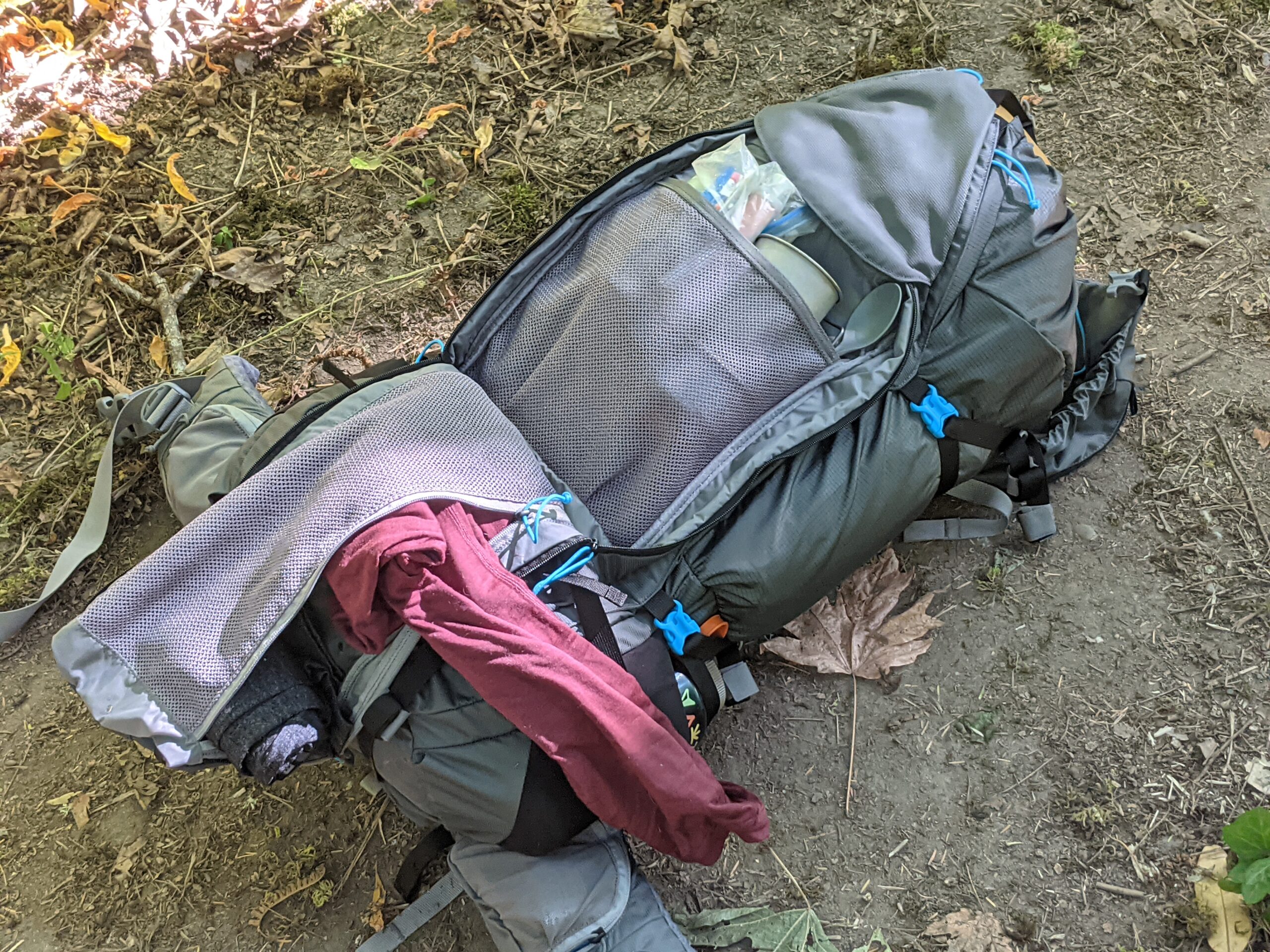
The Mystery Ranch Bridger 65 broke the spell. The testers, who all had the unisex version of this pack, were effusive in their praise, which ranged from “really comfortable” (Ross) to “insanely comfortable” (Helmuth). Similarly, Boyle headed out with a pack that weighed just over 40 pounds and reported that he thought it would be comfortable up to 50 pounds.
Part of this is just that the Mystery Ranch Bridger was more padded than anything else we looked at. The hip belt is plush, the shoulder straps wide and flexible and padded. But what really won the testers over was that all the adjustment points just worked.

Helmuth noted that part of her positive experience was thanks to the Mystery Ranch video that shows how to wear their packs. “It was different than how I had been taught to wear other internal frame backpacks, and I was glad they had this info,” she says. The Mystery Ranch Bridger received the highest marks for fit across the board of anything we tested.
But it wasn’t just the fit that impressed the testers: They also liked the Mystery Ranch Bridger’s unique take on organization. Rather than relying on an external mesh pocket to store odds and ends, there is a more robust front compartment that zips all the way down, revealing internal mesh pockets that will negate the need for separate stuff sacks for parts of your kit, like toiletries or cooking gear. Similarly, the main compartment of the backpacking backpack could be entered through the top, bottom zip, or by unzipping the front panel in a U shape. Inside were two more side mesh pockets for organization. Even more appealing to the tidy backpackers will be the Velcro straps that tie up the loose ends of webbing after your pack is fully adjusted.
There were a few dings. Boyle struggled to fit his sleeping bag into the bottom compartment, and the testers that stored their Nalgenes in the side pockets noted that they weren’t deep enough to hold them securely. Helmuth also reported that both of the trekking pole attachments on her pack broke during testing.
Read the full Mystery Ranch Bridger 65 review to learn more.
| Category | Ross | Helmuth | Boyle | Average |
| Fit | 9 | 10 | 8 | 9 |
| Comfort | 8 | 10 | 8 | 8.7 |
| Load Bearing | 10 | 10 | 8 | 9.3 |
| Storage | 10 | 8 | 7 | 8.3 |
| Accessibility | 7 | 8 | 7 | 7.3 |
| Value | 6 | 5 | 7 | 6 |
| Overall | 9 | 8.5 | 8 | 8.5 |
Best for Men: Deuter Aircontact Core
Deuter Aircontact Core
Key Features
- Capacity: 60 liters (can expand to 70 liters)
- Weight: 5.1 pounds (4.7 pounds for the women’s fit)
- Unisex Torso Fit: 16.5 to 24.5 inches
- Women’s Torso Fit: 14 to 22 inches
- Pockets: Two top lid pockets, two side stretch pockets, front mesh pocket, two hip belt zip pockets
- Adjustment Points: Attached hip belt, shoulder straps, load lifters, adjustable back panel, sternum strap
- Comfortable up to 45 pounds (as reported by the testers)
- Warranty: Lifetime warranty
Pros
- Has every adjustment point and pocket you expect from a backpacking backpack
- A great match for more typically masculine builds
Cons
- Can be difficult for women to balance
- Some durability issues with the mesh
Boyle was effusive in his praise of the Deuter Aircontact Core. He noted several times on his testing sheet that the pack fit amazingly well and that it was the most comfortable pack in the test series. Notably, it supported the typically heavy loads he carries into the Appalachians, and was simple to adjust to his frame using the various adjustment points, including the Variglide back panel adjustment. Boyle also liked that he could move the compression straps around, which made it easier to change up his load when he was out guiding clients through Shenandoah National Park. He noted disappointment that the Deuter Aircontact Core did not include an integrated rain cover (which comes with other Deuter backpacks), and that the mesh sections were slightly fragile if rubbed against an abrasive surface, like a rock wall. But these, for him, were small points. “No matter how much weight I was carrying, I never really felt it,” he says. “The pack fit so well, I could almost forget it was there.”
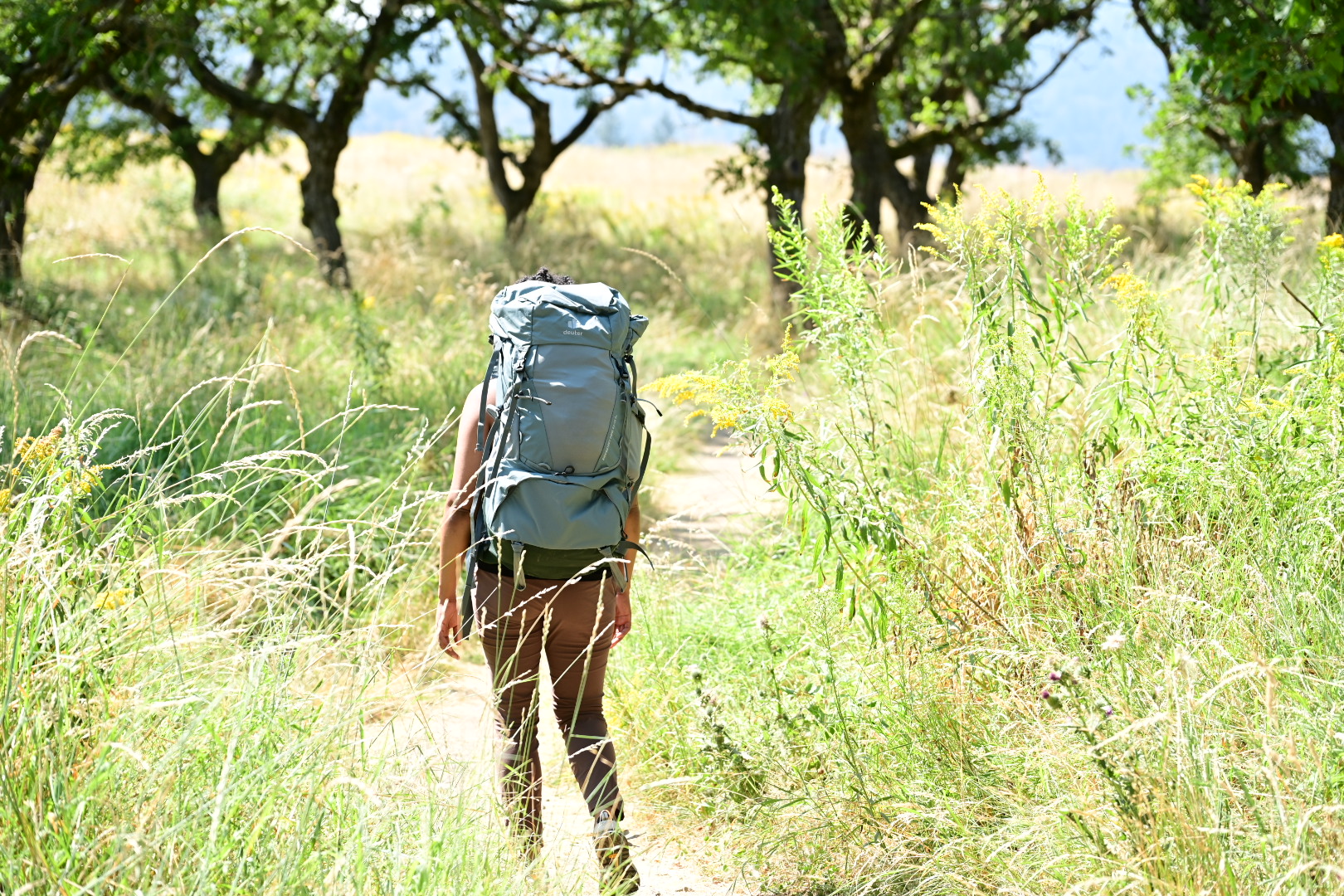
This turned out to be at odds with both Helmuth’s and Ross’s experience. While Helmuth was out on an overnight to the Carbon River in Mount Rainier National Park, she found that when the load lifters were loose, the weight of the pack settled on her hips, but when she cranked them down to help move the weight to her shoulders, the top of the pack would hit the top of her head. Ross reported that her smaller physical stature made this one-size-fits-all backpack even more of a no-go. “The internal frame of the backpack hit the back of my head at such an uncomfortable spot that I turned my overnight backpacking trip into a day hike,” she says. Ross also found that the weight in the pack kept unbalancing while she was out testing, so that the pack repeatedly tipped to one side.
Overall, the ergonomics of this backpack, including its hipbelt, seemed to pair significantly better with men’s more typically streamlined builds. (For this test, Boyle was sent the SL pack, which is considered the women’s fit.)
All three testers noted that the organization of this pack epitomized what they look for in the features of a backpack. A healthy sized sleeping bag compartment. A stretchy mesh back pocket. Two side pockets for water bottles and two hip belt pockets for snacks. A top lid that fits all their important items with room to spare. The top of the main compartment can also be pulled up to expand the pack from 60 liters to 70 liters. Anyone with a typically masculine build that prefers traditional-style backpacking backpacks would be well served by the Deuter Aircontact Core.
Read the full Deuter Aircontact Core review to learn more.
| Category | Ross | Helmuth | Boyle | Average |
| Fit | 3 | 8 | 10 | 7 |
| Comfort | 1 | 8 | 9 | 6 |
| Load Bearing | 9 | 9 | 9 | 9 |
| Storage | 9 | 10 | 8 | 9 |
| Accessibility | 7 | 7 | 8 | 7.3 |
| Value | 3 | 8 | 8 | 6.3 |
| Overall | 1 | 8.3 | 9 | 6.1 |
Best for Women: Gregory Deva
Key Features
- Capacity for a Medium: 65 liters (Baltoro); 60 liters (Deva)
- Weight: 4.9 pounds (Baltoro); 4.5 pounds (Deva)
- Baltoro Torso Fit: 16 to 21 inches
- Deva Torso Fit: 14 to 20 inches
- Pockets: Three top lid pockets, one side stretch pocket, one water bottle holder, front mesh pocket, two front zip pockets, two hip belt zip pockets
- Adjustment Points: Attached hip belt, shoulder straps, load lifters, adjustable back panel, sternum strap
- Comfortable up to 50 pounds (as reported by the testers)
- Warranty: Limited lifetime warranty
Pros
- Thoughtful design elements, including a dedicated water bottle pouch
- Contoured hip belt works well with typically feminine bodies
Cons
- Velcro back panel is easy to inadvertently create a lopsided profile
- Precurved hipbelt was uncomfortable for our male tester
If the Deuter Aircontact Core fit the lone male tester great, while leaving the two female testers struggling, the Gregory Baltoro and Deva were the opposite. Boyle tested the men’s version of this pack (the Baltoro), and reported that, despite being quite padded, the hipbelt felt tight against his hips. Part of this was that the curved shape was somewhat misaligned with his frame; at one point, leaving his phone inside the hipbelt pocket resulted in a bruise.
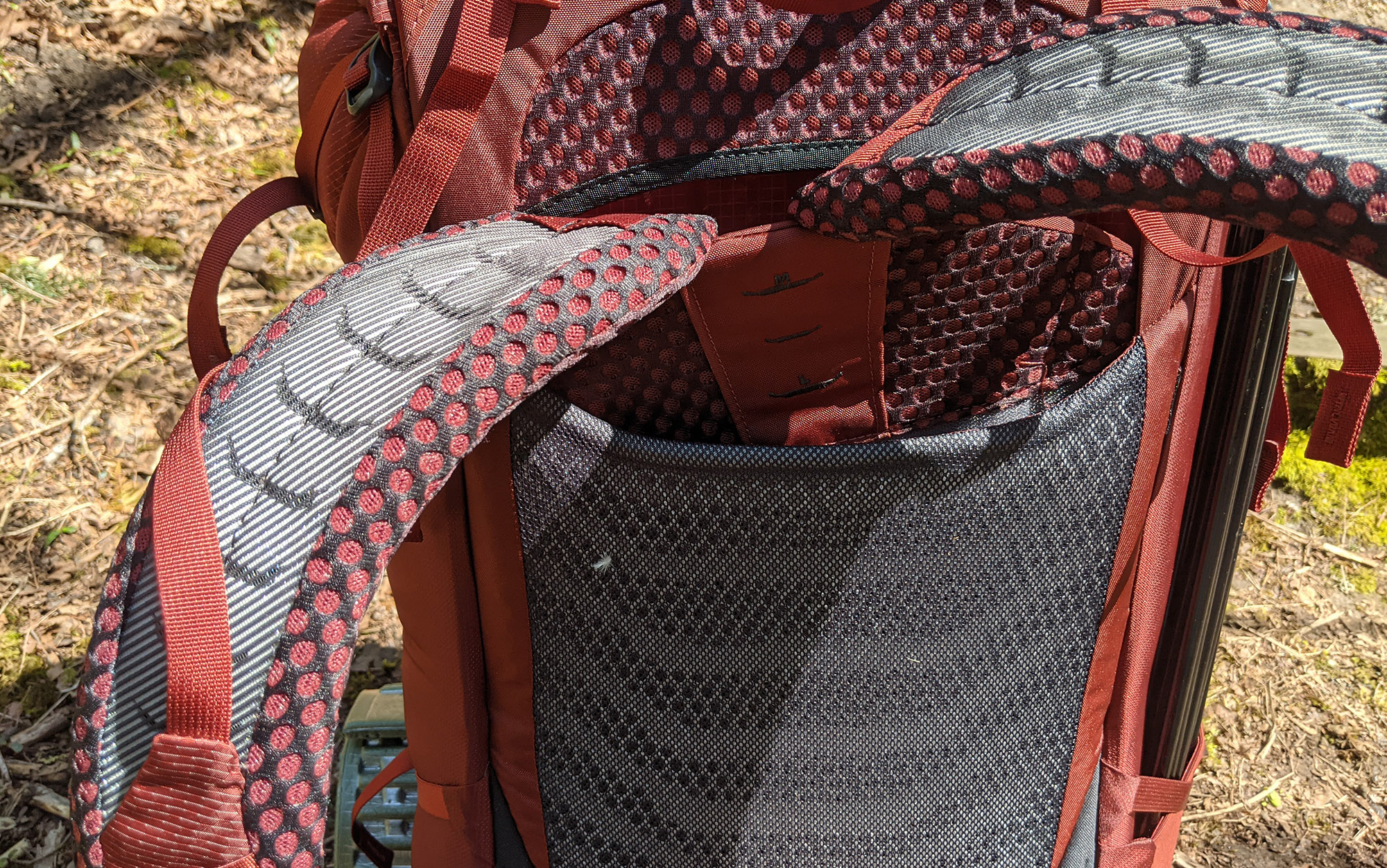
Ross’s and Helmuth’s experience with the Gregory Deva (the women’s version of the same pack) was, fortunately, a different story. Despite initially struggling with the Velcro adjustment panel (lopsided shoulder straps resulted in pain in her left trapezoid), Helmuth felt that, overall, the pack fit her frame well. Ross had a similar experience with the fit of this backpack, giving it a 10 for fit and an 8 for comfort.
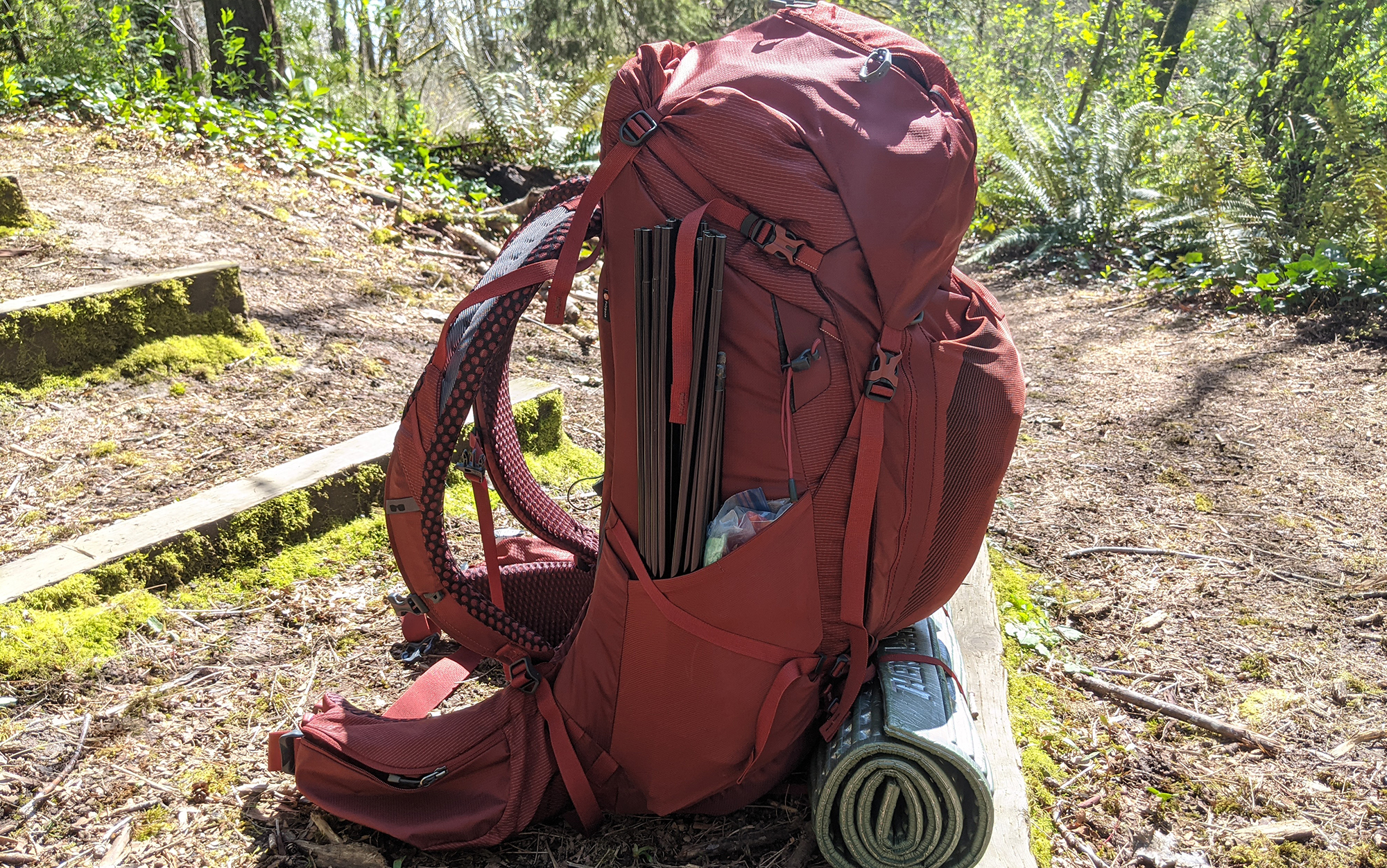
But what really won them over, winning 10 points from each, was the Gregory Deva’s approach to storage and accessibility. Ross liked the three different compartments for the brain. “It allowed me to keep my smaller items organized,” she says. Ross also appreciated being able to easily access the main compartment without unbuckling the brain, as it saved her time when searching for a specific item. Both Ross and Helmuth also commented on how easily accessible their Nalgenes were while hiking, thanks to the dedicated side water bottle holder.
While neither Ross nor Helmuth had any particular difficulty fitting their shoulder season gear into the backpack, Boyle found that his larger gear kit was difficult to fit into the available pockets. “It’s the smallest packing, 65-liter pack I have used,” he says.
Read the full Gregory Baltoro and Deva review to learn more.
| Category | Ross | Helmuth | Boyle | Average |
| Fit | 10 | 6 | 8 | 8 |
| Comfort | 8 | 5 | 6 | 6.3 |
| Load Bearing | 8 | 9 | 7 | 8 |
| Storage | 10 | 10 | 5 | 8.3 |
| Accessibility | 10 | 10 | 6 | 8.6 |
| Value | 7 | 7 | 4 | 6 |
| Overall | 10 | 7.8 | 5 | 7.6 |
Best for Small Frames: Kelty Coyote
Key Features
- Capacity: 65 liters (unisex), 60 liters (women’s)
- Weight: 4 pounds, 10 ounces (unisex), 4 pounds, 6 ounces (women’s)
- Unisex Torso Fit: 15.5 to 21 inches
- Women’s Torso Fit: 14.5 to 18.5 inches
- Pockets: Top lid pocket, two side stretch pockets, two side zip pockets, front zip pocket, hip belt zip pocket, hip belt stretch pocket
- Adjustment points: Attached hip belt, shoulder straps, load lifters, adjustable back panel, sternum strap
- Comfortable up to 30 pounds (as reported by the testers)
- Warranty: Limited lifetime warranty
Pros
- A great fit for shorter torsos
- Affordable
Cons
- Adjustable panel doesn’t provide enough support for longer torsos
- Can’t handle as much weight as other backpacks in our test
It would be hard to overstate how much our smallest tester, Ross, liked this backpack. She ranked it her favorite out of everything tested in the initial round, and still liked it after trying backpacks that cost three times as much. What made this pack incredibly comfortable for her was its fit. “It felt like it was designed for a short torso,” she says.
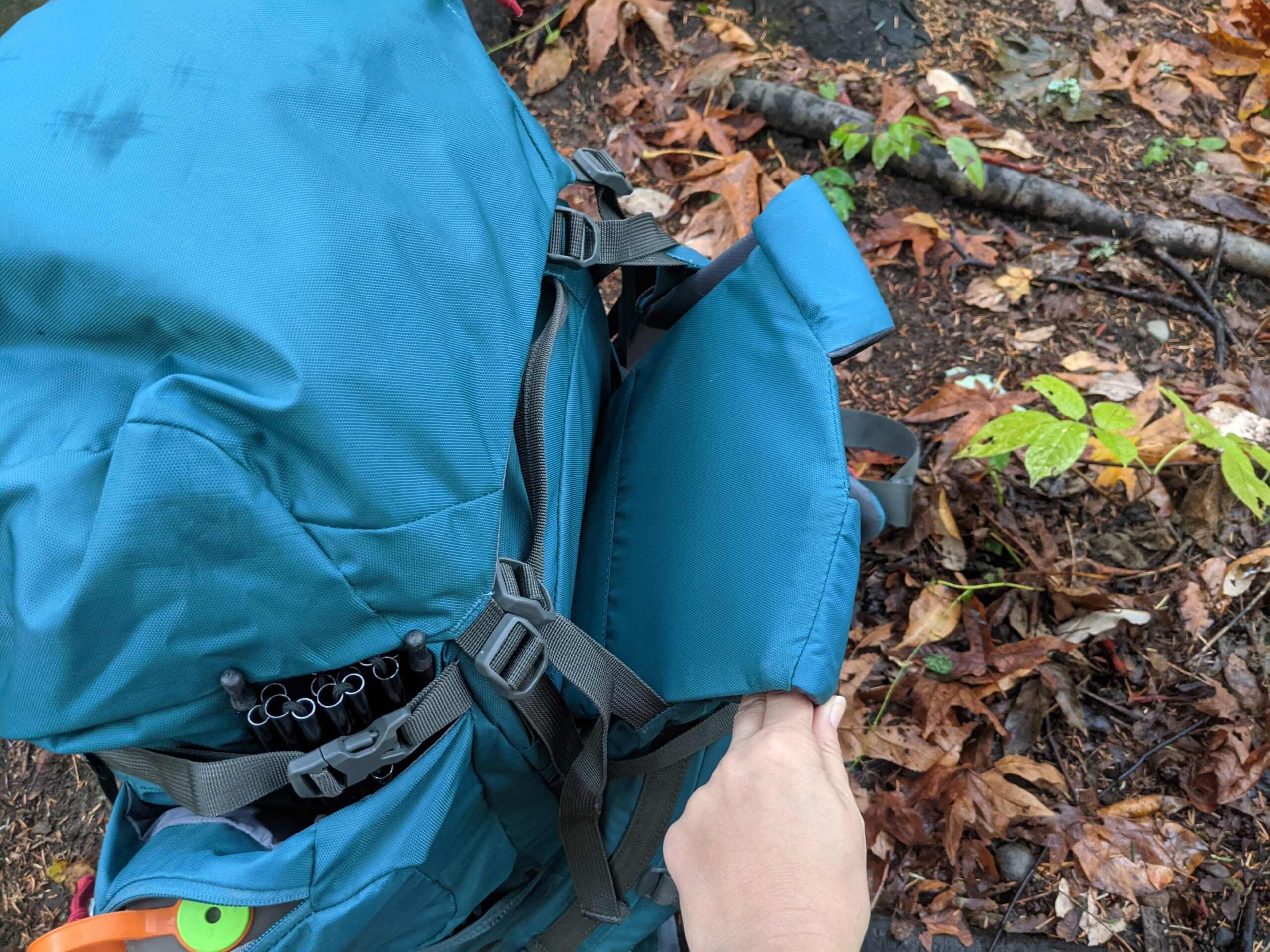
Like other backpacking backpacks we looked at, this pack uses Velcro to hold the adjustable back panel in place. But while the team thought the other backpacks with adjustable were designed for torso lengths in the middle of their stated range (or even on the longer side), the Kelty felt as if it was designed for the absolute shortest torso sizing. Unfortunately, that meant it was not a fit for our tallest tester, Helmuth, who noticed the backpack was pulling back against her shoulders uncomfortably as she hiked.
Read the full Kelty Coyote review to learn more.
| Category | Ross | Helmuth | Boyle | Average |
| Fit | 10 | 4 | 6 | 6.7 |
| Comfort | 10 | 2 | 5 | 5.7 |
| Load Bearing | 10 | 8 | 5 | 7.7 |
| Storage | 10 | 8 | 6 | 8 |
| Accessibility | 9 | 2 | 6 | 5.7 |
| Value | 10 | 7 | 9 | 8.7 |
| Overall | 10 | 5 | 6 | 7 |
Best Ultralight: ULA Circuit
Key Features
- Capacity: 68 liters
- Weight: 37.3 ounces (33.8 in Ultra)
- Available Torso Sizes: S to XL (15 to 24 inches)
- Available Hip Belt Sizes: XS to XXL (26 to 47 inches)
- Pockets: Two hip belt pockets, two side pockets, one large back pocket
- Adjustment Points: Removable hip belt, customizable J- or S-shaped shoulder straps, load lifters, and sternum straps
- Comfortable up to 40 pounds
- Warranty: Lifetime
Pros
- Wide range of sizing options makes it easier to get the right fit
- Customizable if you want bottom straps, ice ax loops, etc.
Cons
- Limited pockets and storage options compared to more traditional backpacking backpacks
One thing that became clear during this testing process is that there is no such thing, really, as a one size fits all backpack. Again and again, backpacks that claimed to fit well across a range of torso sizes or hip widths really worked best for only one or two testers.
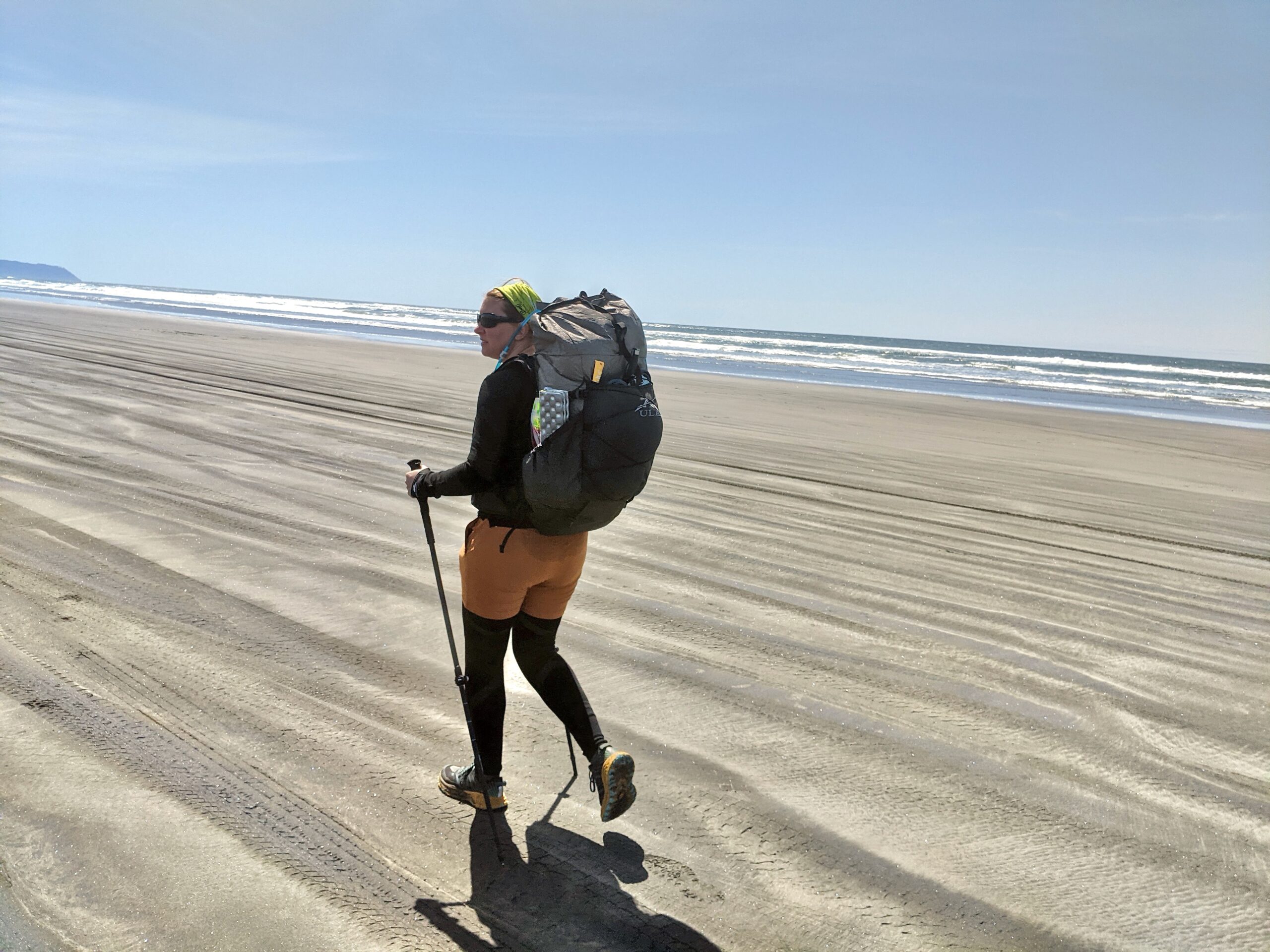
That’s why if you are thinking about going lightweight or ultralight, you should start your journey with our top pick from our ultralight backpack test: the ULA Circuit. What the traditional backpackers on our ultralight testing team liked about the ULA Circuit was that it was intuitive to fit to their bodies based on their previous experience. It has all the usual adjustment points: hip belt, shoulder straps, load lifters, sternum straps, and they all worked in the same way (decidedly not the case for every backpack we looked at for that test).
But whereas traditional backpacking backpacks typically use adjustable back panels to get a just-right fit, ULA has you customize your pack before you even hit the purchase button. There are four different dimensions for the torso length and six different dimensions for the hip belt lengths to choose from. That’s a major boon for backpackers who have struggled to find a backpacking backpack that fits both their torso and hip measurements. If you want to go really wild, you can also choose your exact pockets and features with a Custom Circuit.
Of course, not all traditional backpackers will want to, or should, switch to an ultralight backpack—and that’s OK. During our ultralight backpack test, Patrice La Vigne, who has thru-hiked both the Appalachian Trail and the Te Arorara, found that the different approach to pockets and organization with the ULA Circuit (cavernous main compartment, no bottom entry, no top lid pocket, only one back mesh pocket) was so disruptive to her system for packing and organization that it negated any weight savings benefits.
The Rest of the Field
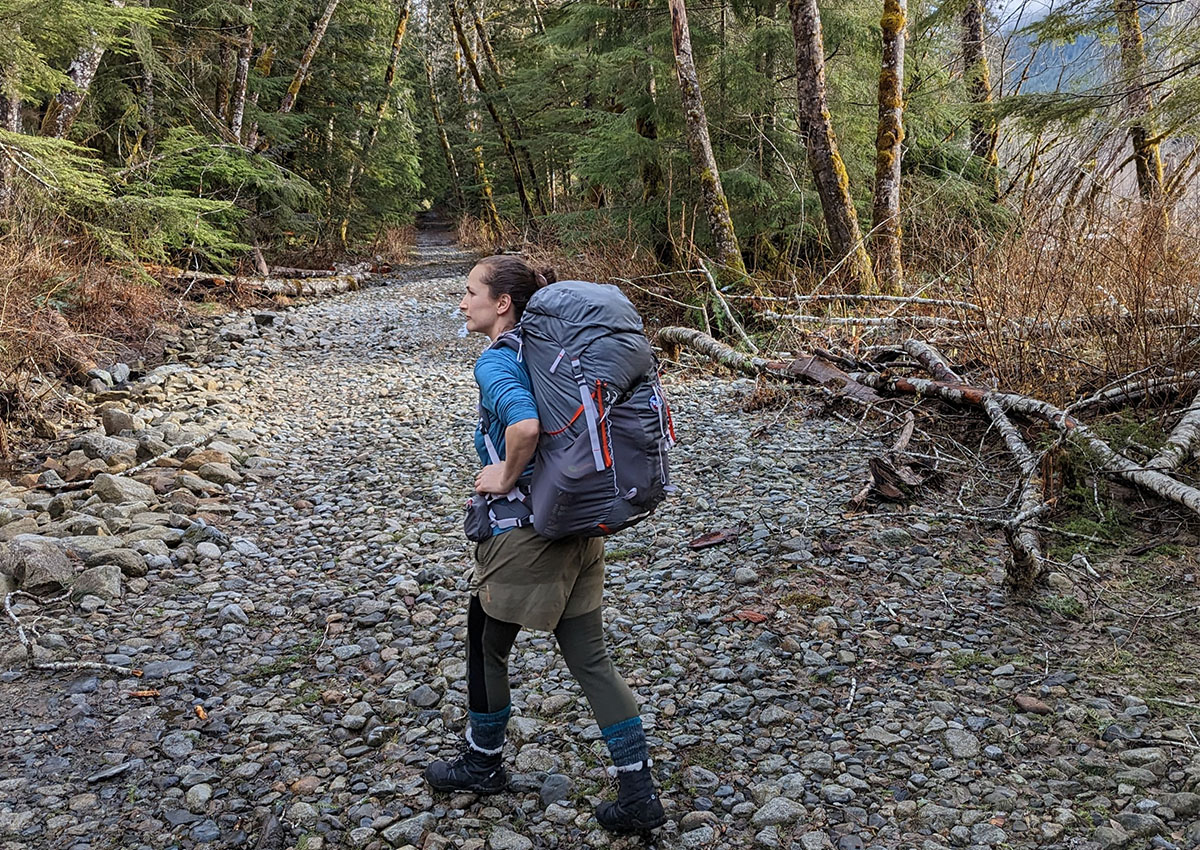
One of the newest entrees into the world of backpacking backpacks is from acclaimed tent and sleeping bag manufacturer, Big Agnes. Our testers checked out their Parkview and Garnett packs, but came away with mixed feelings. While there were aspects of this pack that they thought were true innovations, including its approach to the back panel adjustment, generous side mesh pockets, and the trash can, its overall stiffness (even over multiple trips) made it one of the least comfortable packs we tested in this series. If you are thinking about going lightweight, consider instead our top ultralight pick, the ULA Circuit.
The Six Moons Designs Swift X was another pack that was included in our test of the best ultralight backpacks that stood out from the pack for its comfort. This is in large part because it has more adjustment points than any pack in either our test of the best ultralight backpacks or the best backpacking backpacks. It had: hip belt straps, hip belt stabilizer straps, shoulder straps, back panel adjusters, load lifters, and two sternum straps. You can also choose to pair it with either traditional shoulder straps or the increasingly popular vest shoulder straps—I recommend the latter. Testers noted that while this pack is unusually difficult to adjust correctly the first time you put it on (the adjustment points for the vest shoulder straps were in particular difficult to get a feel for), that it hugs the body very comfortably once you do, without relying on the need for excessive padding. If you’ve tried a number of more traditional backpacking backpacks and just haven’t found the right fit for your body, this is absolutely worth a look.
Things to Consider When Choosing a Backpacking Backpack
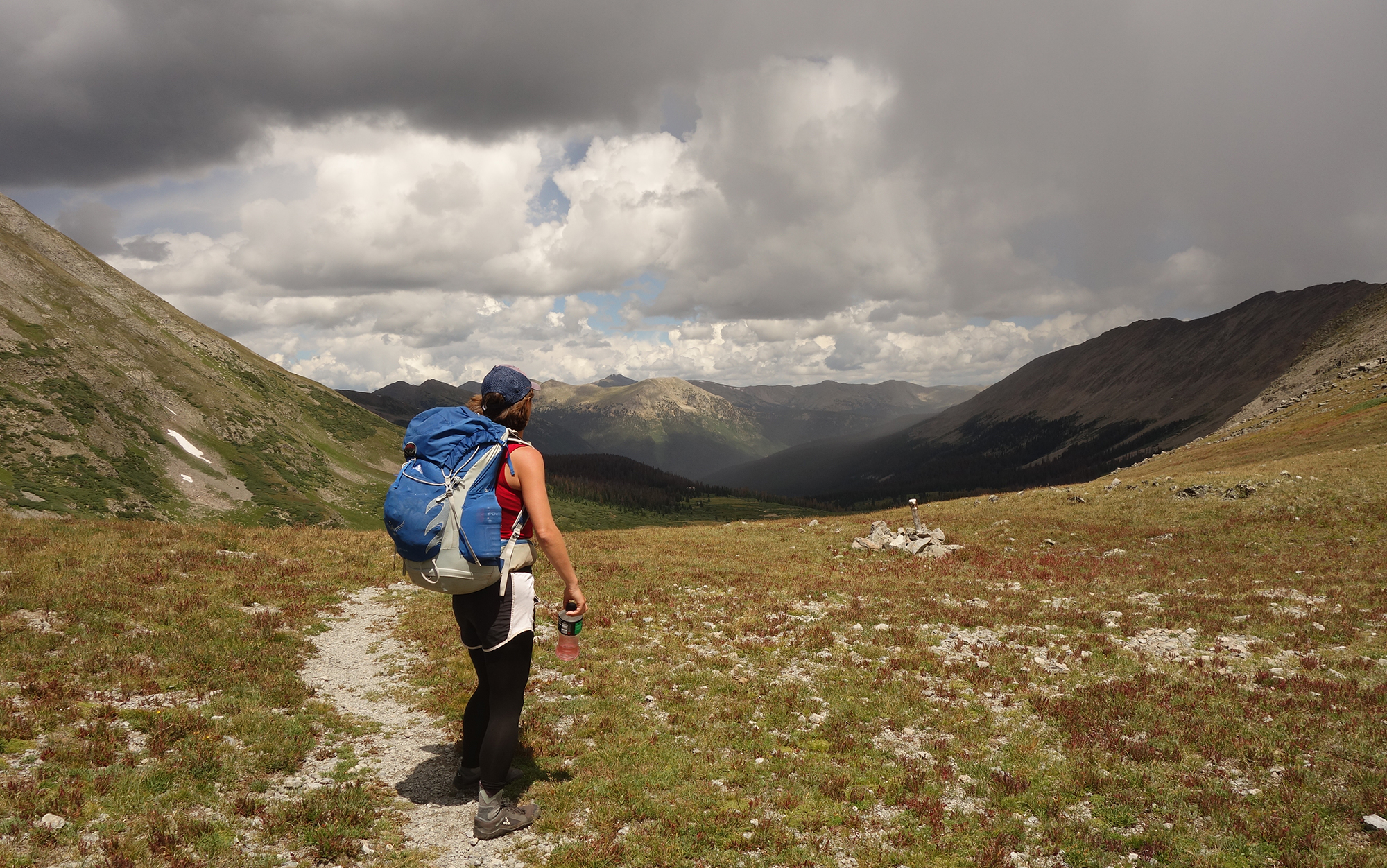
Backpacking Backpack Torso Length
In both our tests of the best backpacking backpacks and the best ultralight backpacks, the biggest determining factor as to whether a pack fit comfortably or not was the torso length. A pack with the correct torso length will keep the load balanced comfortably between your hips and shoulders. A backpack with a too-short torso will weigh down your shoulders excessively. A backpack with a too-long torso will leave you pulling on your load lifters until the top of the pack is hitting you in the head. Our testing further showed that if you are in between torso sizes for your backpacking backpack of choice that it’s better to size down than to size up.
Comfort
Despite their similarities in appearance, it’s clear that the best backpacking backpacks all have different ergonomics, and that they will fit different body types differently. This can make it exceedingly difficult to find advice, as one person’s best-case scenario backpack will leave another person bruised at the end of the day. Before committing to a pack, check what is allowed on the return policy, and then take it out for as long of a hike as you can, packed with your typical kit. This will give you a better idea as to whether or not it is a fit for your body than a simple in-store weighted test (although those are also useful) or getting lost in the myriad of opinions on the internet.
Weight of Your Backpacking Backpack
There are essentially two schools of thought when it comes to backpacking backpacks. One is that lighter is always more comfortable. The other is that stripped-down backpacks lack the padding and support needed for a comfortable carry. Neither of these is exactly right or exactly wrong, but most backpackers will identify with one camp or the other and choose their backpack accordingly. In this review, we’ve focused on traditional backpacking backpacks that prioritize cushion over weight (if you are in the other camp, look at our story on the best ultralight backpacks). However, even within this category there is substantial variation, with packs ranging from 3 pounds to upwards of 6 pounds. Consider your personal size and carrying capacity when making a final choice.
Backpacking Backpack: Storage and Organization
The backpacking backpacks we looked at for this test were all feature heavy, but had surprisingly different approaches to organization. Some had cavernous sleeping bag compartments; some sleeping bag compartments were so small we had to get creative with what went in there. Some had extra pockets in places we didn’t expect (shoulder straps, hidden mesh pockets in the interior). And a few were missing pockets our testers thought were integral to how they packed their bags. If you are choosing a backpacking backpack for the first time, this detail is significantly less important than overall comfort—your packing strategy will ultimately evolve to match your pack. However, if you are upgrading your pack, think about what features are integral to your current systems and try to find a pack that incorporates those into its design.
Read Next: The Best Bear Canisters of 2023
FAQs
Yes, a 50-liter pack is enough for backpacking, although for longer treks you may need to be judicious about what you do and do not bring.
The size backpack that you need for three days of backpacking will depend on the size of your gear, but most people can get away with a 50-liter or less. The biggest determining factor for most beginning backpackers is the size of their sleeping bag (which should be kept inside your pack, to protect it from the elements). If yours is a bulky synthetic bag, aim for a slightly larger backpack. If it’s a svelte high-fill power down model, you can go smaller.
You typically cannot use a 60-liter pack as a carry-on. The exception to this is frameless or minimalist backpacking backpacks, as the longer frames on these can sometimes be compressed down far enough to squeak by. If you are looking for a backpacking backpack that can double as a carry-on, it’s better to go with the 45 liter or less size, and cross your fingers that the airline attendants turn a blind eye when you stroll down the air bridge.
Generally, you want to aim for a total weight, including food, water, gear, everything, of no more than 20 percent of your total body weight. However, the reality is that some packs carry heavier loads better than others. If you prefer to carry a heavy load when backpacking, refer to our testers’ take on the maximum carrying capacity for each backpack in the above story.
Read Next: Best Travel Backpacks of 2023
Why Trust Outdoor Life?
Since 1898, OL has been a leading authority in testing and reviewing hunting gear, fishing tackle, guns and shooting equipment, and much more. We have more than a century-long history of evaluating products, and we’re now bringing that expertise to online reviews. Our editors are experienced outdoorsmen and women, and most importantly, we’re trained journalists. We prioritize field testing and objective data when reviewing products. We conduct interviews with gear manufacturers and engineers as well as outdoor experts so that our readers have an understanding of how and why a product works—or doesn’t.
Advertising does not influence our gear reviews and it never will. While we always focus our coverage on standout products—because we want our readers to be aware of the latest and greatest gear—we also cover the flaws and quirks of any given product.
Final Thoughts on the Best Backpacking Backpacks
Choosing a comfortable, well-fitting backpacking backpack is foundational to your experience in the backcountry. Our experienced testers reported back on how some of the most popular models on the market interacted with the ergonomics of their body types. In most cases, these varied significantly: One tester’s perfect pack would be a nightmare for someone else. When choosing a backpack, remember that your experience and comfort—not the wisdom of the crowd—is paramount. Here is our take on the best backpacking backpacks for different body types:
- Best Overall: Mystery Ranch Bridger
- Best for Men: Deuter Aircontact Core
- Best for Women: Gregory Deva
- Best for Small Frames: Kelty Coyote
- Best Ultralight: ULA Circuit
